Rica's Loudest voice to the World Since 1996












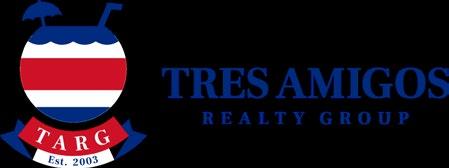












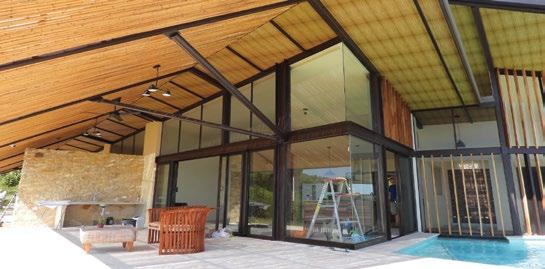

Happy New Year to all! Reflecting on 2022, it certainly seems that it just flew by, we blinked and now it's 2023.

Recently I have had the opportunity to be the target of a few people who seem to want to engage and attack. This is not a new thing for me as a publisher, and even before this career. It leads me to my thoughts on caring about what people think about us.
This subject is widely discussed and has many turns and twists. The reality is that we are all individuals and each has our own way of living and communicating, and we own our opinions. If you have confidence in what you believe in, should you make excuses to appease those who have counter opinions or stand for your beliefs? Get a backbone and own it.
Over the past few years, the divisiveness of allowing people to express their thoughts and beliefs has become an issue. I see it mostly in the world of politics and religion, with groups formulating their dogma, and with vile contempt, label people. This has become a crisis of hindering individual thoughts and beliefs.
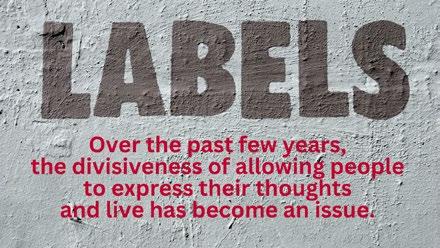

This leads to interactions that are not only uncomfortable, but also a killer of friendships. So many people talk with such authority about issues and have no interest in seeing things from
a different perspective. Is this how we are being educated now? Hold your beliefs at all costs!

I recently had an interaction with a friend about immigration status and allowing migration into the United States. It became a little heated and I was accused of getting my news from Google and being a liberal. This was so funny I just had to stop and absorb the comment. Well, as a matter of fact, I do research and listen to many different news agencies to get a view from different sides. I believe this is well rounded and a proper way to do research. But with such disdain, I was labeled. Marked as an ANTI-something, whatever that might be, I guess following a crowd is what people want these days. Proudly I own my thoughts and the way I choose to live.
I ran across this quote the other day and it just triggered my thoughts on living.
“In the end, people will judge you anyway. Don’t live your life impressing others. Live your life impressing yourself.”
—Rawforbeauty.
This is all a part of being happy with yourself and staying your course. Owning our actions, thoughts and our experiences are what makes us who we are. The need to conform just because they say so is not healthy.
It is better to associate with people who truly allow you as a person to grow and express yourself. Friends don't worry about the little things. Friendship is about the whole experience. We have so few good friends, do you really want to throw them away because they have a difference of opinion? And with that being said, do we always have to be right? Being humble and accepting of others is a great way to live.
Three things you need to remember to keep a humble heart:
1. It’s not how big the house is, it's how happy the home is.

2. If you haven't been in someone's shoes, don’t tell them how to tie their own laces.
3. Remember everything can vanish in a blink of an eye.




There is a need to communicate on a level that is maybe a little kinder and less authoritative when expressing your beliefs, accepting those around us who have different beliefs. Being kind should not have to be forced; it should be natural.

Living in a world that agrees on everything and doesn’t explore options is good? I think it is a slippery slope of what happened throughout history.

news, think about history and how things became a crisis in the world because of forcing beliefs. Remember history repeats itself. Look at what is happening around the world and see if you can identify the point in history that is nearing repetition.


Should we care what people think about us? My answer is yes and no. Live your life and be happy with yourself. If you are going to love others you need to first love who you are.
In 2023, let’s try accepting those with differing opinions and engage in productive, meaningful conversations. We can solve the world's problems with open hearts and open minds.
John B. QuamSurf's up! As waves of high-season activity bring in another new year with a splash, Howler's January issue is full of features and photos geared to Costa Rica beachgoers — from top surf spot tips and swell science information to board shopping advice and rip current precautions.
Looking for something different in the way of agro-tourism attractions? We have two suggestions — one colorful and the other sweet — in our profiles of a sunflower plantation and artisan sugar cane mill, respectively. We also launch a new bird photo series, while adding more artist backstories in a new “Making a Scene” installment.

Charlene Golojuch. Co-owner of Hidden Garden Art Gallery with husband, Greg; www.HiddenGardenArt. com
Ellen Zoe Golden. Former entertainment biz PR flack. Later lived the dream for many years as a travel agent, journalist and surfer in Tamarindo before her passing in March 2022.
Ivan Granados. Managing Partner at GM Attorneys, specializing in real estate and corporate law. igranados@gmattorneyscr.com
Ivo Henfling. A Dutch national,resident of Costa Rica since 1980, and Costa Rican real estate broker for over 30 years. Founder of GoDutch Realty, which covers several locations in the Central Valley, including Escazú, Santa Ana, Atenas, Cariari, and Grecia.
Karl Kahler. Author of "Frommer's Costa Rica 2017," former travel editor of the Tico Times and former national editor of California's San Jose Mercury News.
Jenn Parker. An avid writer, traveler, and nature lover on a mission to surf the earth and share her stories. crjennparker@gmail.com
Rick Philps. Canadian who practiced law in Victoria, BC before moving to Costa Rica in 1998. He has practiced law here for 17 years, having continued his education in civil law and notary and registry law. Offers legal due diligence seminars and consultations in the Gold Coast area for expats moving, or considering moving to Costa Rica. Contact rick@costaricacanadalaw.com or visit www. costaricacanadalaw.com
John Quam Howler Magazine Owner, Publisher and Editor-in-Chief, who has called Costa Rica home for nine years.

Brians Salazar. Attorney and notary public at GM Attorneys. Obtained his law degree at the University of Costa Rica in 2015, and a specialization degree in notarial law in 2018 from Escuela Libre de Derecho University.
Ryan Waldron. BS Atmospheric Science, surfer. ryan@witchsrock.com
Dr. Herbert Weinman. MD, MBA. thedoctorisinsharkfm@gmail.com
See new online puzzles on
PUBLISHER / EDITOR-in-CHIEF
John B. Quam
executive director - Terry Carlile account executive Mary Fernández
Editorial Staff
Debbie Bride - Editorial Coordinator Laurie Quam - Copy Editor
HOWLER (™) 2017
Cont act John Quam - Managing Partner headmonkey@howlermag.com
Editor: editor@howlermag.com
Advertising: terry@howlermag.com Design: design@howlermag.com
CR Office: (506) 4701-5942
Howler Magazine Costa Rica @howlercostarica @thehowlermag @howlermagazine


The Howler Gold Coast CR S.A. Ced. Juridica: 3-101-725213
The opinions, beliefs and viewpoints expressed by the various authors in this publication do not necessarily reflect the opinions, beliefs and viewpoints of Howler organization or its advertisers.
All rights reserved. No part of this publication may be reproduced, distributed, or transmitted in any form or by any means, including photocopying, recording, or other electronic or mechanical methods, without the prior written permission of the publisher, except in the case of brief quotations embodied in critical reviews and certain other noncommercial uses permitted by copyright law. For permission requests write to: info@howlermag.com.
The Howler Magazine does not assume responsibility for the content of its advertisements.
Images not credited are acquired from stock photography services.
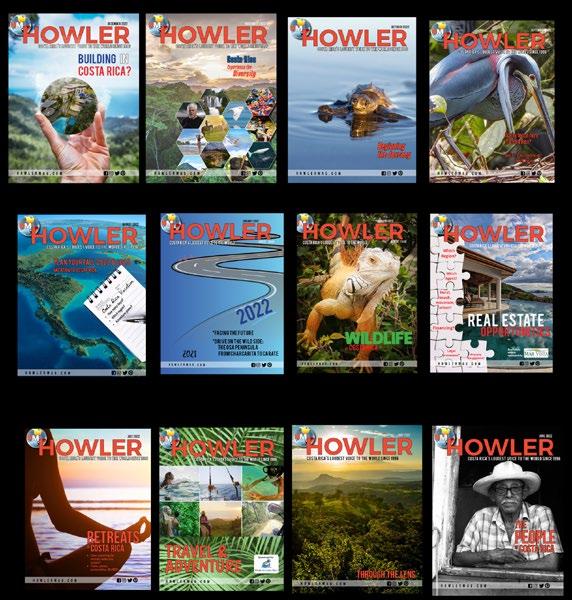



Many people plan their vacation escapes around by catching the wide range of surfing opportunities in Costa Rica. Whether you're a beginner or professional-level surfer, you'll find a destination that will challenge and reward you: the thrill of accomplishment.





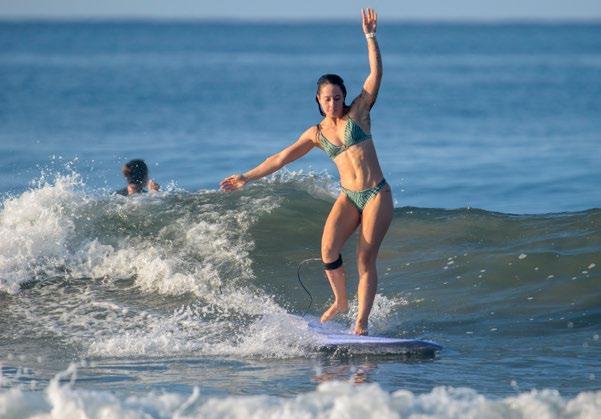

 Photos by James Foxx. Click logo to see more!
Photos by James Foxx. Click logo to see more!



As many Howler readers are aware from past articles about Tamarindo surf legend Robert August, the 1994 movie Endless Summer II secured Costa Rica’s place thereafter as one of the top surf destinations on the planet. From world-class competitors to vacationers getting their feet wet with beginner lessons, wave-bound travelers have been flocking here ever since.
If anyone can appreciate why this country was named “Rich Coast,” local and expat surfers likely have their own lists of favorite spots with special reasons. And they might only scratch the surface, as Howler has managed to do over the years in our always-popular Surf Spot column. Join us now in revisiting a favorite few of many.
Click on buttons linked to complete individual articles
• Ollie’s Point
• Playa Hermosa
• Mal Pais
• Playa Negra
Ollie’s Point
Put on the map and made popular by the film Endless Summer II, Ollie’s Point, off of Costa Rica’s northern Guanacaste coast, was named after Oliver North. Howler’s fascinating March 2018 cover story, Ollie’s World, recounts the infamous U.S. lieutenant colonel’s role in the 1980s, smuggling weapons to the Sandinistas during the Nicaraguan Civil War against the Contras.
by John QuamOllie's Point is located a short distance to the north of Witch’s Rock, and is referred to in Spanish as Potrero Grande. This right-hand point break is one of the most sought-after places to surf in Costa Rica. Next to Santa Rosa National Park, it beckons surfers to a very isolated location accessible only by boat. It is recommended that your surfing ability should be in the range of good to experienced.
Hermosa means “beautiful” in Spanish. This beach and town fit that name well. The uncrowded beach is wide and over four miles long, perfectly lending itself to take a walk enjoying the salt mist and constant surf sound. It is not a good beach for swimming due to the dangerous riptides.
Serious surfers love this place because of its big waves and quiet and uncrowded beaches. What more could you ask for?
Putting Playa Hermosa on the map and making this a sought-after surfing destination was easy. In 2020 Playa Hermosa was designated the first World Surfing Reserve in Central America.
Playa Hermosa is not recommended for beginner surfers. But Jacó, just five miles to the north, is a great place to learn.

Located on the Nicoya Peninsula, Mal Pais and its nearby neighbor to the north, Santa Teresa, were recently voted by Forbes Magazine as “one of the 10 most beautiful beaches in the world.”
This slow, relaxing village is a fishing town and is less developed than Santa Teresa. If you want serenity and to avoid the crowds, Mal Pais is the place. It has beautiful rocky beaches as well as stretches of sandy ones littered with sea shells.
There are lots of water sports here besides surfing. Scuba diving, fishing, and kitesurfing are just some of the activities. Exploring the coastline and just relaxing in this paradise are good for your soul.

Just a short distance south of Tamarindo in the Guanacaste Province, Playa Negra is considered another one of the the best surf spots in Costa Rica. The closest town to Playa Negra is Los Pargos, meaning “the snapper.”
This surf break is another place made famous by the Bruce Brown-directed movie Endless Summer II. Easy to get to, Playa Negra is considered one of the country’s best places to surf. It is a rock reef bottom and has a great righthand barrel.

A left-breaking wave appears depending on the direction of the tides and swells. It is a constant surf spot year round due to its exposure to the northern and southern hemisphere swells.
A 2012 earthquake that lifted the tectonic plate changed the Playa Negra wave to have better form in the combination of higher tides and smaller swells.
The area around Playa Negra has a lot of options for dining. The town can get crowded because of its popularity and proximity to Tamarindo.
Be aware of the currents; there are riptides in this area.
Click icon for more:
Local and expat surfers likely have their own lists of favorite spots with special reasons.
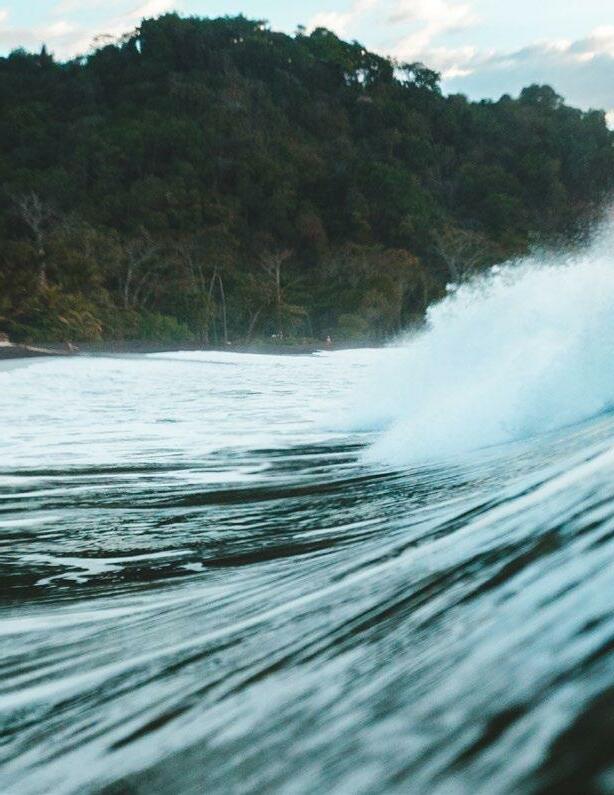 by Ryan Waldron
by Ryan Waldron
Waves are nothing more than traveling vessels of energy. Born from strong winds blowing in all corners of the planet, ocean waves traverse thousands of miles through open water just to come crashing down for our enjoyment. Aside from the visual aesthetics of watching perfectly peeling waves, an experienced surfer can also obtain detailed information about a wave’s origin just by observing a few specific qualities in the surf zone.
In terms of surf destinations, Costa Rica certainly ranks among the leaders worldwide. With the all-year consistency of water conditions, variety of surf spots, perfect climate, and overall wave quality, it’s almost impossible not to score the best waves of your life here. Swells are a key factor. Let’s look at Costa Rica’s swell producers, when each of these events occurs and some Howler insider tips to aid your search for the next perfect wave.
These are the swells that provide Costa Rica with consistent surf throughout most of the year, making it a year-round surf destination. Because there are no significant land masses blocking the howling winds of the south Pacific, major storms can swirl at the low latitudes for several days, giving us extended swell events (three to five days) with long-period wave energy (14 to 22 seconds).
Although you can catch these SPAC swells throughout the year, your best chance for catching “The Big One” is between June and September. During these months, surfers can expect a diurnal wind pattern each day with offshore winds in the morning, light onshore breezes during the day, and an evening glass-off for sunset. South Pacific swells can come from a range of directions and angles — 170° to 240°.
Insider tip: To light up Tamarindo, the swell needs to be greater than 210°. Beaches with direct south exposure receive more of this swell energy. Playa Grande is an example.


Costa Rica has never been known for hurricanes until Hurricane Otto passed over in November 2016 and Tropical Storm Nate in October 2017. During the peak months of the Pacific hurricane season, tropical cyclones off the coast of Mexico will send a quick shot of medium-period swell (10 to 14 seconds) in our direction.
This only happens a few times a year, but when a nice pulse of northwesterly hurricane swell impacts the region, most beaches can expect fun, peaky waves along the coast. Furthermore, hidden nooks and crannies that you would never think to check will light up unexpectedly with the unique swell angle (280° to 310°). The wind this time of year can be a bit more unpredictable, but there is usually a favorable window in the morning, and sometimes during the day with a passing shower. When all the elements align, these can be some of the best swell events of the year.
Insider tip: Head to a beach break with a wide swell window that can pick up northerly and southerly swells for peaky, powerful waves. Avellanas is an example.
Click icon for more:
It’s almost impossible not to score the best waves of your life here.
Iwoke at 12:30, 1:30, 2:30, and finally rose at 3 a.m. with one of several alarms that I set in fiveminute intervals. Before a surf adventure, I find sleep to be sparse and nearly impossible outside of short nap-like bursts of rest. Anticipation is like a steady drip of caffeine. I was anything but tired when I walked into the kitchen to press the
coffee button on. I would be joining three other guys whose names also started with the letter “J,” and with whom I had never surfed before, at a spot I have long had reservations about. A response of “no” is never in my vocabulary though when it comes to a surf adventure.

Matapalo nearly two hours before sunrise is an adventure in and of itself. High beams, prescription glasses, and my naturally slow approach to driving saved several sleeping sheep who chose the middle of the road on the other side of a blind curve as their ideal resting place. I dodged purple and orange land crabs, toads, and an opossum on the dark narrow road before reaching Charlie’s Bar. My coffee was still too hot to drink — a good thing for that steady anticipation drip. The last message I had received late Friday afternoon included instructions for where to meet at 4 a.m. and to not be late.
The boys rolled up at 4 a.m. on the dot. As someone who is perpetually punctual, I knew at this moment that the four of us were meant to adventure together. I hopped in their car with my board, and we were off chasing the sunrise and the south swell. We all hailed from different countries, but at various stages of our lives chose Costa Rica as our home, drawn and kept here by the waves among other things.
A little less than three hours later, the four of us were standing in the beachfront backyard of a man named Cundino, following left lines running north across a river mouth and into a bay with our frothing eyes. The wind fluttered offshore,

and the tide was sucked out so far you could almost walk out to the 300-meterlong wall of Amazon-brown ocean. The thought of crocodiles, bull sharks, and sewage almost instantaneously dissipated when I noticed the prestigious Blue Flag and perfect peelers. An abandoned plastic baby doll adorned the wooden sign that marked the spot where we would have our first surf of the day.
I opted to sit deep and wait for the steeper set waves that sporadically passed through, since I was the only one not on a longboard. As a lone sea wolf, this is often my approach when the lineup is crowded. For three stroke-heavy hours, I only randomly caught a glimpse of the three other “J’s” catching a wave or paddling back out after a seemingly never-ending ride. Sometimes it would be 10 minutes or more between sets that I could scrape into.
Click icon for more:

I would have waited all day for a wave like that!
What makes a good surf spot? Any nonsurfer might think it’s ridiculous how surfers group together fighting for the same waves despite having the entire coastline to choose from. With seemingly endless miles of breaking waves, why do surfers choose to sit within such close proximity?
The unfortunate truth is, when it comes to wave quality, all beaches are not created equal. For example, on a trip to Witch’s Rock (Roca Bruja), first-timers may feel a bit discouraged by their initial wave check in Playas Del Coco. Even though the two beaches are situated a stone’s throw away on a map, there is an enormous difference in wave size.
Diving deeper into the subject of what makes a good surf spot, we must acknowledge two characteristics. The first is swell window. In other words, does the beach have the correct geographical orientation to receive the full force of oncoming swells?
In addition to swell window, we must also recognize a second characteristic: unique geographical features. Because most surfers are not up-to-date with their geographical jargon, we have coined our own names to describe the unique layouts of different beaches. Here are the most popular.
These are the most common types of surf spots. Beach breaks are sand-bottomed surf zones that have an open swell window. The swell approaches the coastline from deep water and will crest as it reaches shallow water. Witch’s Rock is a great example of a beach break. Not only are the sandbars deposited perfectly, but the famous rock sitting offshore will refract oncoming swells so there are nice, peaky waves in the surf zone.
Point breaks are dreamy for three main reasons: higher percentage of quality-shaped waves, predictability of each wave and increased length of ride.
Traveling towards the coast from the open ocean, a swell will always break first in shallow water. When an individual swell line approaches an abnormal point in the coast, the wave will uniformly peel along the point, creating perfectly groomed waves. Costa Rica is fortunate to be blessed with some of the best point breaks in the world. If you want leg burning lefts, head down south to Pavones. If you prefer a zippy right-hander that looks like Kelly Slater’s wave-pool, cruise up to Ollie’s point.

Mostly reserved for advanced surfers, reef breaks are powerful surf spots that receive the brunt of open ocean swells. From deep water to shallow water almost instantaneously, reef break waves will conserve most of their energy traveling towards the coast, and then release it at once upon the reef. If you are an experienced surfer who's not afraid of taking a few bounces off the bottom, Playa Negra is a popular reef break in the area. Quick word for the wise: mind your manners out there or you might not be welcomed back.
Tamarindo is a prime example of a proper river mouth wave. The meandering estuary separating Tamarindo from Playa Grande deposits sand right in front of Witch's Rock Surf Camp, creating fun, sand-bottomed waves with consistent form. Because the river mouth is meandering (like a slithering snake) the sandbars and surf zones will constantly be changing from one season to the next.
Depending on the season, rivermouth waves can range from mushy peelers to sandspitting barrels. Anyone remember a few years ago when the estuary right-hander was worldclass?
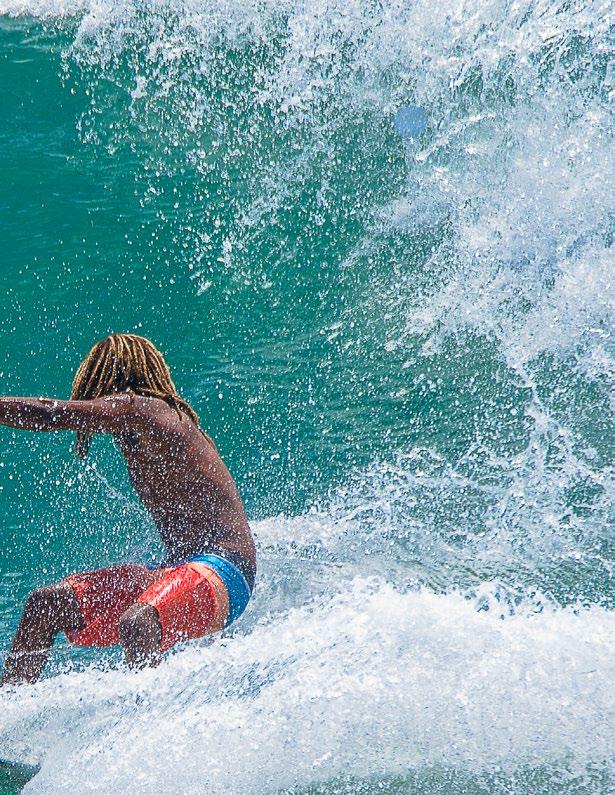
The power of two waves is greater than one. A true wedge wave is fast, powerful, and also a bit dangerous. Just as the name suggests, a wedge is when two waves collide at the perfect angle to create one "juiced up" wave. This effect is normally caused by a man-made jetty or a natural rock-pile within the surf zone to rebound the waves. Surfing a wedge can be tricky, but if you find yourself in the magic pocket where the two waves combine, get ready for a human slingshot! El Hoyo in Caldera is a prime example of a real wedge.
We might not be geographers, but we sure are witty when it comes to detailing surf spots. Overall, surfers are looking for two things in a good surf spot: powerful waves with good shape. So familiarize yourself with your local spots, carefully read the swell charts, and know when to pull the trigger for your next score-fest!
Click icon for more: We might not be geographers, but we sure are witty when it comes to detailing surf spots.

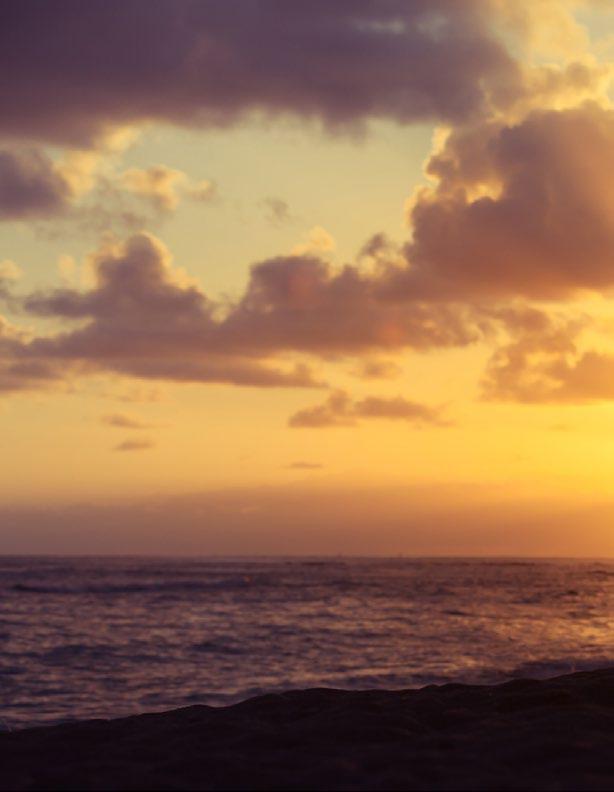
Experienced surfers work with their shaper to come up with just the right board or boards to use for different types of wave conditions and breaks. It’s not just a simple matter of going into a shop and picking out the nicest looking board. It’s a process of taking into consideration your skill level, body weight, where you want to surf and what the waves potentially look like. Of course, it’s also a matter of whether you are going to rip from bottom to lip, fly into tricks or choose a beautiful glide or nose ride.
Here’s a general look at what each type of surfboard offers. Keep in mind that with further individual specifications, a board can do even more than what’s noted.
These are thinner, shorter, highperformance boards that need to be pumped from rail to rail, with pressure on the back and alternating to the front. Shortboards are great for steep, fast and powerful waves of some size. Because of the speed, a surfer can launch into the air for more challenging maneuvers or power surf up and down the line. Achieve lots of rocker, pointy nose and usually a 3-fin setup. Takeoff is closer to the peak, so strong paddling is necessary.
Sometimes called an egg, the funboard generally comes between 7 and 8 feet long. It has a wider nose, gentle rocker, and the same fin setup as a shortboard. The extra stability of these boards offers a nice easy ride in smaller waves, but they also handle well when it gets a bit larger out there. Funboards are a good transition for a longboarder who wants to move shorter, but keep up an easier paddle, maybe out more towards the shoulder.
Historically, the longboard was the original wave ride. And it’s come a long way since those heavy wooden planks with no fins. Today, logs of 8 feet and longer are the best option for a smaller wave as the extra floatation can help a surfer get into a knee-to-shoulder roller easily. Glide with a single fin or stabilize with a traditional 2 plus 1 setup. The extra volume holds up the front end for noseriding. Be prepared to catch more waves out there, with a lot of graceful style.
Here’s your best bet for buoyancy — the option of a shortboard style but with easier access to rides in smaller waves. It’s all about the volume on these surfboards, which are generally around 6 feet and under. They have fin setups of double or even quads, and a tail that, well, looks like a fish: wide with a deep cut in the middle.

Guns are made for the bravest souls who take on the biggest, most hollow waves. They are longer, with less width, a pointy nose and a pointy tail. For those huge, sometimes vertical drops, take out the gun for double overhead and higher.

Over the last decade, hydrofoil boards are gradually making their way into the lineups. In the paddle out, they look the same as any other shortboard, but below the surface is the hydrofoil — a mounted ski that acts as a keel — causing the board to rise above the water with speed. How does that work? Since waves are energy moving through water, the hydrofoil taps into this energy attaining speed.
Click icon for more: With further individual specifications, a board can do even more than what’s noted.
Rip currents are the leading surf hazard for all beachgoers. They are particularly dangerous for weak or non-swimmers. Rip current speeds are typically one to two feet per second. However, speeds as high as eight feet per second have been measured — faster than an Olympic swimmer can sprint! Thus, rip currents can sweep even the strongest swimmer out to sea.
More than 100 drownings due to rip currents occur every year in the United States. More than 80 percent of water rescues on surf beaches are due to rip currents.
• Look for any of these clues:
• A channel of churning, choppy water
• An area having a notable difference in water color
• A line of foam, seaweed or debris moving steadily seaward
• A break in the incoming wave pattern
None, one or more of these clues may indicate the presence of rip currents. Rip currents are often not readily or easily identifiable to the average beachgoer. For your safety, be aware of this major surf zone hazard. Polarized sunglasses make it easier to see the signs of a rip current.
• Never swim alone.
• Be cautious at all times, especially when swimming at unguarded beaches. If in doubt, don’t go out!
• Whenever possible, swim at a lifeguardprotected beach.
• Obey all instructions and orders from lifeguards.
• If caught in a rip current, remain calm to conserve energy and think clearly.
• Don’t fight the current. Swim out of the current in a direction following the shoreline. When out of the current, swim towards shore.
• If you are unable to swim out of the rip current, float or calmly tread water. When out of the current, swim towards shore.
•
If you are still unable to reach shore, draw attention to yourself. Face the shore, wave your arms and yell for help.
Many people drown while trying to save someone else from a rip current. If you see someone in trouble:
• Get help from a lifeguard.
• If a lifeguard is not available, have someone call 911.
• Throw the rip current victim something that floats and yell instructions on how to escape.
Awareness makes for a safer surfing and swimming adventure
Click icon for more:

Click to learn more:



JAN 14 3rd Quarter
Day High Low
Sun 01
High Low
4:11 am 1.30 ft 10:23 am 7.40 ft 4:21 pm 1.55 ft 10:50
Mon 02 5:15 am 1.38 ft 11:27 am 7.24 ft 5:23 pm 1.80 ft 11:49
Tue 03 6:15 am 1.32 ft 12:28 pm 7.25 ft 6:21 pm 1.90 ft
Wed 04 12:43 am 8.26 ft 7:08 am 1.17 ft 1:22 pm 7.39 ft 7:15 pm 1.87 ft
Thu 05 1:32 am 8.31 ft 7:55 am 0.98 ft 2:10 pm 7.60 ft 8:03 pm 1.77 ft
Fri 06 2:17 am 8.40 ft 8:37 am 0.77 ft 2:54 pm 7.82 ft 8:46 pm 1.63 ft
Sat 07 2:58 am 8.49 ft 9:16 am 0.59 ft 3:34 pm 8.04 ft 9:27 pm 1.47 ft
What is Costa Rica's #1 export? How years Howler been published?
Sun 08 3:38 am 8.54 ft 9:53 am 0.47 ft 4:12 pm 8.22 ft 10:06 pm 1.35 ft
Mon 09 4:17 am 8.53 ft 10:29 am 0.42 ft 4:49 pm 8.33 ft 10:45 pm 1.27 ft
Tue 10 4:55 am 8.44 ft 11:04 am 0.47 ft 5:26 pm 8.36 ft 11:23 pm 1.25 ft
Wed 11 5:33 am 8.25 ft 11:39 am 0.61 ft 6:02 pm 8.33 ft
Thu 12
12:01 am 1.29 ft 6:11 am 7.99 ft 12:15 pm 0.82 ft 6:39
Fri 13 12:41 am 1.38 ft 6:50 am 7.68 ft 12:52 pm 1.07 ft 7:17 Sat 14 1:23 am 1.50 ft 7:32 am 7.35 ft 1:31 pm 1.33 ft 7:59
Sun 15 2:10 am 1.60 ft 8:19 am 7.05 ft 2:16 pm 1.57 ft 8:46
Mon 16
Which Howler section gets the most reads?
3:02 am 1.66 ft 9:14 am 6.84 ft 3:07 pm 1.75 ft 9:40
Tue 17 4:01 am 1.61 ft 10:16 am 6.79 ft 4:07 pm 1.82 ft 10:41
Wed 18 5:05 am 1.41 ft 11:23 am 6.97 ft 5:13 pm 1.70 ft 11:45
Thu 19 6:08 am 1.02 ft 12:28 pm 7.40 ft 6:20 pm 1.38 ft
Fri 20 12:47 am 8.71 ft 7:09 am 0.50 ft 1:28 pm 8.00 ft 7:23 pm 0.90 ft Sat 21 1:46 am 9.16 ft 8:04 am −0.07 ft 2:24 pm 8.67 ft 8:22 pm 0.35 ft
Sun 22 2:41 am 9.57 ft 8:57 am −0.59 ft 3:16 pm 9.29 ft 9:17 pm −0.13 ft
Mon 23 3:33 am 9.86 ft 9:47 am −0.96 ft 4:06 pm 9.78 ft 10:10 pm −0.46 ft
Tue 24 4:24 am 9.96 ft 10:35 am −1.11 ft 4:55 pm 10.04 ft 11:01 pm −0.58 ft
Wed 25 5:14 am 9.82 ft 11:23 am −1.02 ft 5:44 pm 10.06 ft 11:52 pm −0.46 ft
Thu 26 6:03 am 9.46 ft 12:10 pm −0.69 ft 6:33 pm 9.83 ft
Fri 27
Sat 28
Sun 29
Mon 30
Tue 31
What is the name of the only Costa Rican born astronaut?
What the peak Costa
12:43 am −0.13 ft 6:54 am 8.91 ft 12:58 pm −0.16 ft 7:23
1:35 am 0.35 ft 7:47 am 8.25 ft 1:48 pm 0.50 ft 8:15
2:31 am 0.88 ft 8:43 am 7.59 ft 2:42 pm 1.19 ft 9:12
3:31 am 1.35 ft 9:46 am 7.04 ft 3:41 pm 1.80 ft 10:12
4:37 am 1.66 ft 10:54 am 6.71 ft 4:47 pm 2.22 ft 11:16
High Sunrise Sunset Moonrise Moonset
10:50 pm 8.37 ft 5:56 AM 5:29 PM 1:28 PM 1:27 AM
11:49 pm 8.27 ft 5:56 AM 5:30 PM 2:11 PM 2:17 AM
5:57 AM 5:30 PM 2:57 PM 3:08 AM
5:57 AM 5:31 PM 3:45 PM 4:00 AM
5:57 AM 5:31 PM 4:36 PM 4:52 AM
5:58 AM 5:32 PM 5:28 PM 5:44 AM
5:58 AM 5:32 PM 6:19 PM 6:34 AM
5:58 AM 5:33 PM 7:10 PM 7:21 AM
5:59 AM 5:33 PM 7:58 PM 8:05 AM
5:59 AM 5:34 PM 8:45 PM 8:45 AM
5:59 AM 5:34 PM 9:30 PM 9:23 AM pm 8.25 ft 5:59 AM 5:35 PM 10:15 PM 10:00 AM pm 8.15 ft 6:00 AM 5:35 PM 11:01 PM 10:37 AM pm 8.05 ft 6:00 AM 5:36 PM 11:48 PM 11:15 AM pm 7.98 ft 6:00 AM 5:36 PM 11:55 AM pm 7.97 ft 6:00 AM 5:37 PM 12:39 AM 12:39 PM 10:41 pm 8.07 ft 6:01 AM 5:37 PM 1:34 AM 1:28 PM 11:45 pm 8.32 ft 6:01 AM 5:38 PM 2:35 AM 2:25 PM
6:01 AM 5:38 PM 3:39 AM 3:27 PM
6:01 AM 5:39 PM 4:46 AM 4:35 PM
6:01 AM 5:39 PM 5:52 AM 5:43 PM
6:01 AM 5:40 PM 6:53 AM 6:49 PM
6:01 AM 5:40 PM 7:47 AM 7:50 PM
6:01 AM 5:41 PM 8:36 AM 8:47 PM
6:01 AM 5:41 PM 9:21 AM 9:41 PM
6:01 AM 5:41 PM 10:04 AM 10:32 PM pm 9.40 ft 6:01 AM 5:42 PM 10:45 AM 11:22 PM pm 8.85 ft 6:01 AM 5:42 PM 11:26 AM pm 8.29 ft 6:01 AM 5:43 PM 12:09 PM 12:13 AM 10:12 pm 7.83 ft 6:01 AM 5:43 PM 12:54 PM 1:04 AM 11:16 pm 7.55 ft 6:01 AM 5:43 PM 1:42 PM 1:56 AM



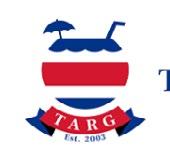













When it comes to property exposure, noone does it better than us.
Looking to sell your property in Costa Rica? Let us help! Our local network websites receive over 8 million annual page views, and with over 20 million views on our Coldwell Banker Global affiliate sites, you can trust that your property will get the attention it deserves.




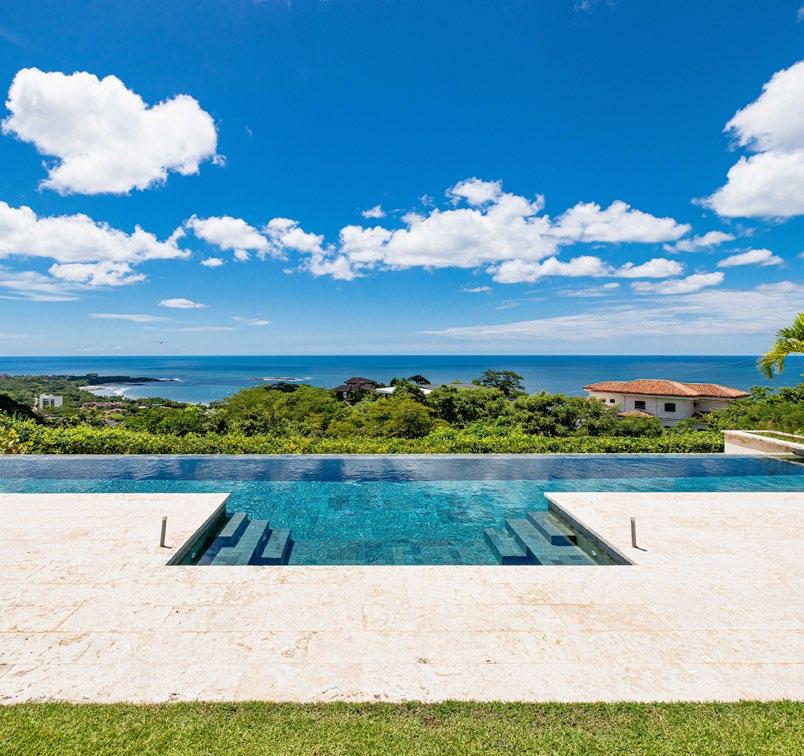
ONCE you’ve settled into your new Costa Rican property, let Horizon Pacific Management & Rentals put our 17 years of experience in property maintenance and vacation rental marketing to work for you. Beautiful views from one of our properties in La Vista Condos. Contact us for its rental availably. HorizonPacificVacations.com




Rock Patterson

15 years in Real estate in California, Florida and Costa Rica. 25 years in Healthcare Leadership.
Lawyer and notary, with emphasis on civil law and Real Estate purchase process, and also has good business networking with public institutions and municipalities in the area.
Lana Taal
29 years in Real Estate. Extensive experience in business related to the area of commercial, tourism and agricultural projects in Costa Rica, Panama and Colombia.
Ana Cecilia Solano



Lawyer and notary, with emphasis in Real Estate. Expert in private financing and mortgage loans and extensive experience in all types of litigation.

Fraud and security specialist. 18 years of experience managing large-scale
Experienced businessman emphasis on restaurants Estate around business networking institutions in Guanacaste.

 Mario Flores
Luz Ruiz
Mario Flores
Luz Ruiz

specialist. experience in large-scale events.
Over 10 years’ experience and under Costa Rica legislation, Engineering, Construction and Inspection License. Skilled in supervising smooth and timely execution of projects.
Flores businessman with an restaurants and Real around the country. With a networking in government in the northern area of


Research associate, with extensive personal contacts in the Real Estate area throughout Costa Rica, focusing on commercial, agricultural, and tourist properties.



Architect and urban planner, with an emphasis on commercial and residential construction. He has 10 years of experience. Has a long list of more than 400 projects in his professional history.



Sun Real Estate specializes in the Guanacaste Real Estate Market.

We have a significant amount of unique Mountain Real Estate, Beach Properties or just beautiful Farm Land to offer.

As an independent Real Estate Broker, our experts cover a variety of locations ideal for living, retiring or investing in Guanacaste.
Hot Springs and Mountain Farms, such as Residential and Building lots, Commercial Land, Hotels, Titled Beachfront Farms, for development also very huge properties.
Business ideas are what Sun Real Estate listings include.

Johannes Valentin Beriè, known as Hans is a German entrepreneur and the owner of different companies, working as a proven and successful businessman, for 30 years in Costa Rica, with different kinds of views, and greatly connected everywhere, to get things done.
With Sun Real Estate he formed a team of specialists and solvers of critical situations, for any type of happenings, to lead the clients to a positive outcome.
Hans never lets his clients run alone before and after a successful closure, he always watches them and makes sure they are in a safe place.






by Howler Staff Adapted from a facretriever.com post Links are to related Howler articles
1. From northwest to southwest, Costa Rica measures only 285 miles (460 km.) and at its narrowest, it is only 74 miles (120 km.) wide. It is smaller than Lake Michigan.
2. In 1539, officials in Panama used the name Costa Rica (Rich Coast) for the first time, to distinguish the territory between Panama and Nicaragua.
3. On September 8, 1502, Christopher Columbus became the first European recorded to land in Costa Rica. He took refuge just off the coast between tiny Uvita Island and the current port of Limón.
4. Costa Ricans claim that Dr. Clodomiro “Clorito” Picado discovered the properties of penicillin before Dr. Alexander Fleming, based on a paper Dr. Picado had published in 1927 on how penicillin inhibited the growth of streptococcus in his patients.
5. Costa Rica has a 96% literacy rate. For rural areas where children can’t make it to school, lessons are taught over a national radio station.
6. Native Costa Ricans call themselves Ticos and Ticas.
7. Costa Rican women do not take their husband's last name when they get married. They keep their maiden name for life along with their mother’s maiden name.
8. In Costa Rica, nearly all Catholic churches face west.
9. Coffee was introduced to Costa Rica from Jamaica in 1779. Called the grano de oro (grain of gold), coffee was Costa Rica’s foremost export for 150 years until tourism surpassed it in 1991. More than 247,104 acres of coffee are planted in Costa Rica, making it the 13th largest coffee exporter in the world.
10. In Costa Rica, a soda is a small, informal restaurant that serves chicken, beans, rice, and salad at prices that are generally lower than average.
11. Like Eskimos with their 57 words for snow, Costa Ricans have at least a dozen terms for rain — from drizzly pelo de gato (cat hair) to a baldazo or aguacero (downpour) and a temporal (heavy rain falling for several days without letting up during the rainy season). The heavy amounts of rain give Costa Rica more rivers and a higher volume of water for a country of its size than any other nation except for New Zealand.
12. Instead of saying “my other half,” Costa Ricans refer to their significant others as their “media naranja,” or “the other half of the orange.”
13. A common phrase used after a Costa Rican woman has a baby is "Ella dio a luz," meaning literally “She gave light.”
14. Costa Rican currency is officially called the colón, but Costa Ricans often use the word harina (flour) to refer to their money.
15. Costa Rican catadores, or tasters, decide which coffees to buy and are as important as wine tasters are in France. They train for five years to learn exactly how to slurp the coffee off a spoon onto their taste buds, and they taste it cold — a good coffee should taste just as good cold as hot.
16. Bri Bri is the one indigenous language still spoken in Costa Rica.
17. Costa Rica's deadliest snake is the ground-dwelling fer-de-lance, a 9.8-foot-long pit viper that accounts for more than 80% of the country's fatal snake bites.
18. Costa Rica is the second largest exporter of bananas in the world after Ecuador.
ACE articles are translatable into 12 different languages, top 3:




Manuel of
From treasured tradition to budding tourist attraction, the Agüero family trapiche (sugar cane mill) at Paso Agres, Turrubares, is an emblem of local values and customs worth preserving.
In that spirit, the Agüeros have taken steps to become an attractive agrotourism destination promoted throughout the Josefino canton by Hiking Turrubares and their sugar mill tours.

Continuing to operate the trapiche in an artisanal way, with laborintensive roles performed entirely by family members — and an oxen team — sets it apart from most other sugar mills in this area of Costa Rica.


The overlap between family life and work in the trapiche is what the Agüeros enjoy most about continuing a legacy that began about 50 years ago. That’s when the initial mill owner and patriarch, Sergio Agüero Ulate, moved with his family from Puriscal to Paso Agres. Eventually, his nine children were ready to take part in this “beautiful and traditional task,” as they regard the family business: sons, Gerardo Humberto, José Antonio, Adolfo, Luis and "Yeyo;" and their sisters, Maritza, Zaida, Lilliam and Carmen. Their mother, Antonia Agüero, has been a mainstay of continuous support.
Everyone in the family helps each other at various cane milling stages, beginning work at 3:30 a.m. on grinding days. Some cut the cane and others prepare the oxen and put them to work. Someone is in charge of lighting the fire and grinding the cane. Another stokes the fire with wood and bagasse. When the cane juice begins to boil, both children and adults approach to savor the foam.
After that comes the process of preparing the thickening boiled juice for pouring into round molds.



“It's hard work, but it keeps the family together, sharing the produce with each other and the neighbors,” says Gerardo, the oldest Agüero brother. “To live and enjoy an unforgettable experience is the idea behind preserving the trapiche for many more years as a sweet memory.”
But Gerardo is realistic about the prospect of the younger Agüero generations pursuing different ambitions. He states with some nostalgia, “The effort has been great to stay in a job that is arduous, but that is not enough to live and support a family. In the midst of everything, the children have studied, and the grandchildren too. None of them want to continue with this. When we are no longer here, I think this will end."



For information about visiting the Agüero sugar mill, location and contact email:



Welcome to Howler’s recently introduced Artist Spotlight series called "Making a Scene." In every issue, we’ll feature the selected works of a different artist, sharing personal insights into the inspiration and creative process behind each one.
Next up is Susan Adams, whose paintings have been showcased in previous Howler articles. We hope you enjoy catching up with Susan and her amazing backstories of the images she has brought to life on her painted canvases.

Frequently I travel to various animal parks and reserves. On one trip I went to a macaw and jaguar refuge in Puntarenas, and from there drove to Puerto Calder to explore further. As it turned out, the jaguars were sleeping and the macaws were flying very fast and seemed to be fighting with each other. Good inspiration for another time.
On the drive back home there was a huge flood! I drove for over an hour where I couldn't even see the road with the water above the bumper. Once the rain stopped and the water receded, I spotted the most beautiful sunset ever! From this, Pointed in the Sun was inspired and created.
Originally on a quest searching for orchids to use as inspiration for my next piece, I went to La Garita, in Alajuela, very near the San José airport. There are many viveros (nurseries) here full of orchids, and an extravagant event center with lakes and acres of orchid gardens and arches for weddings.
While there, I saw these gorgeous macaws and was told that they probably had flown over from "Zoo Ave," just down the road. Now called Rescate Wildlife Center, it's a 35-acre rehabilitation and rescue center with wildlife enclosures.

In Jungle Primp, the bird on the right is actually a hybrid of a scarlet macaw and a great green macaw. It seemed like there were macaws everywhere around this place. Currently there is a program in our area that is reintroducing scarlet macaws back into their natural habitat! Simply amazing!
Ritmo AzulA long time ago, while snorkeling on the Caribbean coast of Costa Rica, I came across this rock which, for some reason, fascinated me. It was a high tide and a rocky shoreline, not sandy like in Guanacaste. Maybe I liked the rock because it had a profile that reminded me of my dog, Lily!
One day recently, I had been hiking with Lily and came across some quartz stones near my house. It brought back memories of snorkeling and that big rock, so I decided to do a little study. Then I liked it so much that I created a large painting.
It seemed like there were macaws everywhere around this place.Jungle Primp
Crawling across the ground on my belly underneath some barriers, I was able to stick my camera under the fencing of the large forested enclosure to snap photos of my favorite jaguar, Rafa, at Las Pumas Rescue Center and Sanctuary. Back in 1989, I met the founder, Lily Hubner, and back in the day she allowed me to enter some of the enclosures with her when she worked with the jaguars. Rafa loved for her to scratch his ears. What a sight to behold!
Of course, the passage of time and new regulations ended that perk for me, but it's thrilling to walk through the sanctuary, which has been greatly improved, with enlarged habitats for the animals being rehabilitated. In this painting, Rafa was sunning himself on a log, sniffing the deer in the adjoining enclosure, when he seemed to have this huge smile — for some unknown reason to me. I just had to capture the scene on canvas. I added a blue morpho butterfly because they were flying all over the enclosures that morning!



 Jaguar Feliz
Jaguar Feliz


This luxurious turn-key property in Santa Teresa, Costa Rica offers breathtaking ocean views and features 4 master bedrooms with private bathrooms, an infinity pool, outdoor entertainment area, high ceilings, detailed finishes, and spacious areas. Located in a gated community just a short drive from the town center, it is the perfect seasonal home or investment in the thriving tourism industry of Costa Rica. The area boasts world-class surfing and beautiful white sand beaches. Don’t miss out on this one-of-a-kind opportunity to soak up the lifestyle this stunning area of Costa Rica has to offer.

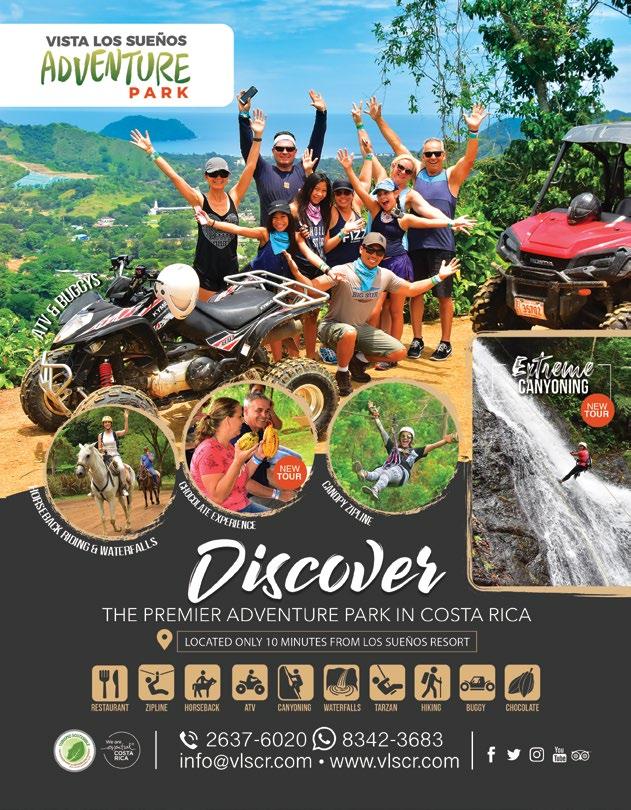


SDiscover a Paradise on Earth along Costa Rica’s north side of the majestic Rincón de la Vieja volcano. We are










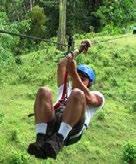







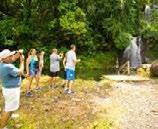










“Our purpose is to create great memories for each person who joins us every season.”English Spanish French Travel & Adventure articles are translatable into 12 different languages, top 3:
When you are feeling a bit blue, or in a perfectly good mood, strolling through a field of more than 100,000 sunflowers is sure to put a big smile on your face. And there’s a place in Costa Rica where visitors can enjoy this delightful and unusual ecotourism experience on a seasonal basis.


Girasoles de Costa Rica (Sunflowers of Costa Rica) will soon be reopening to showcase its latest crop, expected to be ready in February. Located at Pital de San Carlos in Alajuela, this glorious field of gold on 2 hectares (about 5 acres) will feature more than 15 different types of sunflowers in varied colors and sizes — some up to four meters tall.
“We always try to make every plantation better, with different and new experiences in every season,” said Erick Porras of the brainchild project he unveiled in August 2021. “We only open our sunflower field two or three times a year, and always use our social media to share and keep people updated with information about our next seasons.”
A quick glance through the comments on the Girasoles de Costa Rica Facebook page reveals how successful the tour hosting venture has been, and how excited followers are about visiting again or for the first time.
“Our purpose is to create great memories for each person who joins us every season,” Porras stated. “For example, we are now planning to have dinners in the middle of thousands and thousands of sunflowers, under the stars. Can you just imagine that?”
Day or night, sunflower immersion “therapy” is sure to brighten the spirits of anyone who partakes. Then there are the lifepreserving benefits, Porras adds, of protecting the bees and the environment with no chemical or pesticide use.

To discover more, and to view photos, videos, and directions to visit Girasoles de Costa Rica:


CLICK HERE:
by Howler Staff Photos courtesy of Girasoles de Costa RicaPhoto

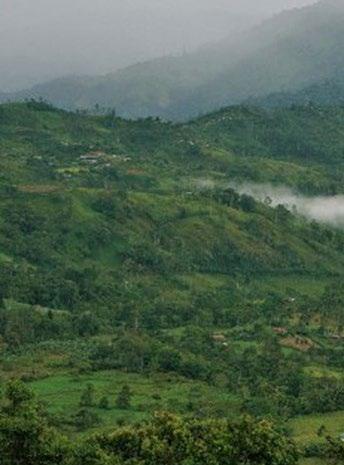
collared was photographed high mountains Cartago, Rica, at about elevation. I little fellow Nobody's Watching.”


Howler readers are invited to tune in to the Ocho Verde Wildlife Channel on YouTube, featuring our jungle animal wildlife adventures in southern Costa Rica. We are always uploading videos of the amazing animals that we find in the rainforest.

We utilize trail camera videos of unusual animals that live in our forest. Some videos capture any snakes or lizards that we come across on day and night hikes. It’s always in a fun spirit.
We may even include videos of a cool day trip that we took, with some of the sights, sounds and food we had. It’s usually pretty good too. We may explore some of the customs and traditions that make the people of Costa Rica unique.
So jump in with us and take a look at why we enjoy this place so much!
We are involved in many wildlife projects, from big cat conservation to snake awareness. We provide simple laminated charts for local people to easily and quickly distinguish a venomous snake from the non-venomous ones. This keeps people and the snakes out of danger.
All proceeds from your likes and subscriptions, or ad revenue, go back into rainforest initiatives.
Take a look at why we enjoy this place so much! CLICK:



One of the beautiful aspects of Costa Rica is the variety of opportunities for adventures. Literally there is something for everyone. The extremes are real, from being lazy chillin’ in a hammock by the beach to trekkin' a volcano trail to adrenaline rush jumps.
Deals in Costa Rica presents a small fraction of the adventures that await your next vacation/escape. We highlight examples in just five regions to intrigue your adventuresome spirit. Click on the buttons for more information.
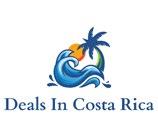

There are two major international airports. Check to see which one is nearest your desired locations to visit.






 by Ivo Henfling
by Ivo Henfling
Ialways see blogs from realtors about all the great and positive things. Most sugarcoat their reporting, but I see never one that shows the cons of living in Costa Rica. I am well known for giving it straight up, although some don’t like it.
I think Costa Rica is a third-world country, pretending to be a second-world country. This is why many things might not be up to your standards. Some people love to complain; they do it all the time. Especially when they made a move here without doing their homework. Then it’s everyone else’s fault and never their own.
So, before you make the step of moving here, read this article first. Then you cannot say it wasn’t your fault; you were well informed!
by GoDutch RealtyOf course, our beautiful country has hundreds of advantages and incredible things going for us, which is the reason for being on everyone’s retirement list. But, in my opinion, you should also know some of the cons of living in Costa Rica, so you can jump into your adventure well-informed.
This article is not a complaint about Ticos and their habits, but quite the opposite. I love it here! It’s meant to warn newcomers about the negatives they can expect to find here and to give them simple solutions.
Some Ticos might not like my comments when they read this blog. For their information, I’ve been here since 1980, I’ve married two Ticas (over 30 years in my second marriage now), my kids are Ticos, and I’m fluent in Spanish, among other languages. I have had several businesses and hundreds of employees.

Let's check out these cons of living in Costa Rica now.
If you have an appointment with Ticos, they’ll usually arrive late or not show at all. We call it Tico Time. Foreigners who have lived here for a while adapt quickly and do the same.

Solution
Call to confirm the appointment a couple of hours before. Bring a book, and don’t wait more than 15 minutes.
Costa Ricans do not have much discipline in traffic. Nobody pays attention to road demarcation, signs, and lights. Stop signs are ignored, and drivers will jump a red light because it’s Sunday. Motorbikes use the double yellow divider line as a lane.
Purchase an SUV that’s big enough to feel safe. Don’t fix the dents until you sell the car.
We don’t have street names and numbers. Our address is more a description of locating a well-known or well-visible place and then so many meters from there, using cardinal points. Often, we use the name of a building or a tree that disappeared 15 years ago.
Install Waze on your phone and ask the party visiting to send you the Waze location.
You’ll always find long lines in banks and government institutions like the water, power, phone company, municipality, and even the grocery store. That’s because they have more counters than attendants. Besides, who is in a hurry anyway?

Slow down — you’re in Costa Rica, and you’re supposed to enjoy life now. Bring a book, smile and be happy! A smile will get you a lot more than getting mad.
Read the rest of the story and see all Pura Vida articles which are translatable into 12 different languages, top 3:
English Spanish French
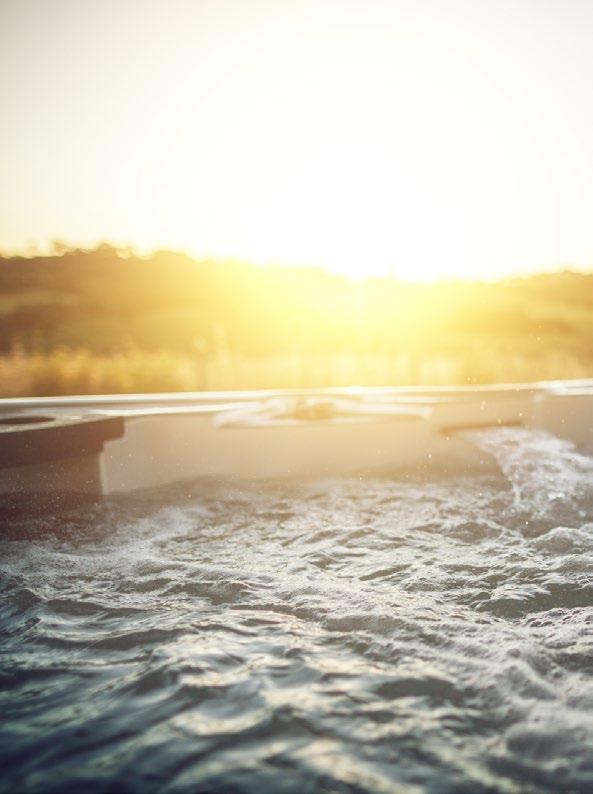 by Dr. Herbert Weinman
by Dr. Herbert Weinman
Soaking in a hot tub is very popular and is more than a mere pastime. The steaming, whirling waters are relaxing and renewing. For many, hot tubbing is also an extremely social ritual.
Hot tubs not only make you feel good, but they can also be therapeutic. Hot water, especially as it spins and whirls, stimulates circulation and relaxes muscles. It relieves arthritis, sprains, sciatica, muscle spasms, sore joints, stiff necks, and back pains. A dip in a hot tub can also be reviving after exercise, or act as a natural sedative to induce sleep.
But hot tubs are not for everyone. If you have high blood pressure, or take sedatives or tranquilizers, stay out of the hot water. Anyone who has been drinking alcohol should also avoid this activity as alcohol raises body temperature. A physician should be consulted if there is any doubt about the effect of hot tubbing in specific situations.
To avoid dehydration, drink roomtemperature water before, during and after hot tub activity — drinking cold water can shock your system.
Some people feel so comfortable in the hot tub that they want to stay for hours, but 20 to 30 minutes is all the time anyone should be in a hot tub continuously. Prolonged exposure to the heat can deplete energy and stress the heart. A hot tub can lull one into a false sense of security, which promotes a longer stay.
In order to keep the water in a hot tub in good condition and to maintain proper hygiene, the water should be clear and without strong chemical odors. The chemicals and pH balance must be checked frequently. It is preferable to have an automatic chlorinator and sensor that feeds chlorine when needed and maintains pH balance.
Chlorine is almost always a chemical choice for killing harmful bacteria, but some people think it’s unhealthy. If too much is used, people with sensitivities may get burning in their eyes or break out in a rash. Fumes, especially indoors, are a feature of chlorine that’s detrimental to health.
Bromine is a better choice for bacteria control because it doesn’t emit a noxious odor, and is more economical because it is held in hot water and requires less maintenance.
Lovers of the hot tub are heirs to a very old tradition. Ancient Egyptians and Chinese built bath chambers. The Greeks and Romans created luxurious bathing areas complete with heated water, cold showers and plunging pools. “Water therapy” is practiced today in India, Turkey, Russia and Finland, as well as American Indian cultures. In contemporary Japan, a visit to neighborhood hot baths is still a family ritual.
If you love hot tubs, why not enhance the pleasure by adding special herbs and aromatic oils to the water? Ancient traditions knew how to do it. Lavender oil, for example, is an incredibly relaxing aroma, while chaparral relieves sunburn and soothes the skin. Check with a natural food store for more product information.

Hot water, especially as it spins and whirls, stimulates circulation and relaxes muscles.
agringado — having adopted a gringo style of speaking alborotado — can mean rowdy, riotous or noisy; agitated or excited; hasty or reckless; or even horny, like a dog in heat codo — Literally “elbow,” but used to mean miserly, cheap, frugal concho — rude, mean, ill-mannered dejado — “left,” meaning neglected, as someone’s looks or hygiene, or like a car that’s not maintained espantoso — “scary,” meaning ugly, filthy or terrible estresado — stressed out lavado, limpio — “washed,” “clean,” meaning broke, out of money necio — annoying. “No sea tan necio, déjame en paz” — “Don’t be so annoying, leave me alone.” ostinado — desperate or fed up
bebé — baby güila — child; “un güila,” a boy; “una güila,” a girl chamaca/chamaco — girl, boy chica/chiquilla/chico/chiquillo — girl, boy mocoso — “snotty-nosed,” an uncomplimentary word for a child; a brat muchacha/muchacho — girl, boy niña/niño — girl, boy pelado — hairless, meaning a child tierroso — covered in dirt, meaning a small child tripudo — pot-bellied; a chubby child


Agriculture has always been vitally important to Costa Rica’s self-sustainability, while also playing an integral part in the Gross National Product for more than two centuries. The country’s diverse climates ensure a wide variety of fruits and vegetables can thrive, while dictating where these cash crops are best grown.
Coffee, specifically, is harvested from plants grown in the cooler mountain regions. It has been Costa Rica’s leading export product since the end of the

The introduction of international big business into the economic equation has resulted in monoagriculture plantations producing solely one of the next three biggest food export crops: bananas, pineapples or sugar.

Overall, Costa Rica’s fruit and vegetable production accounts for about 10% of the nation’s economy, comprising about one-fifth of its labor force. Agriculture, in turn, uses about 10% of the country’s land. It is a compact investment with very high
Click here to continue reading
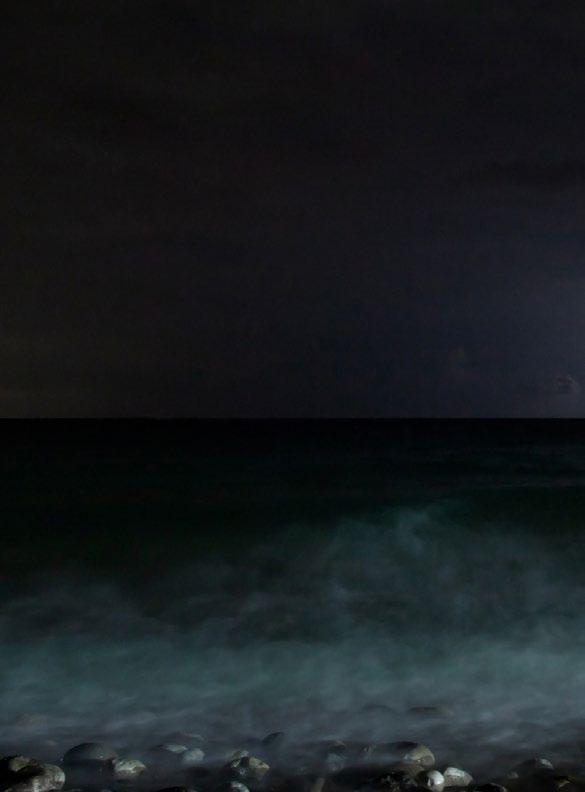
In 1971, I set out on a stormy November cruise from Vancouver, northward to a remote barren island called Amchitka in the Alaskan Aleutian archipelago.
The ship was called the Greenpeace Too and our objective was to stop a bomb. Not just any but a five-megaton nuclear bomb buried under the island, a test by the United States of an insane of mass destruction, one more test in a series of test that had already killed thousands of seals, sea otters and fish from shock waves.
We failed to stop that test, but as a result of our intervention, all further underground tests were banned and in 1972, I became a founding director of the Greenpeace Foundation.
In 1974, Robert Hunter, Dr. Paul Spong and I initiated the Greenpeace campaigns to protect Soviet whaling fleet in the North Pacific. In 1976 and 1977, David Garrick and I initiated the Greenpeace seals off the East Coast of Canada.
It was in 1975 when a wounded Sperm whale spared my life that I became forever committed and I vowed to myself to eradicate the evil of whaling in my lifetime.
It was in 1977 when to save the life of a baby harp seal, I pulled a club from a Newfoundland carried the seal pup away from the man who wanted to kill it. For that one act, the Greenpeace Board accusing me of theft (the sealer’s club) and vandalism (tossing it into the sea). They said was something I could not do and if the situation rose again, I would do the exact same thing.
In response to my dismissal, I established the Sea Shepherd Conservation Society with the intervene, to obstruct, to harass and to sabotage illegal whalers, sealers, fishing operations, turtle
I considered my dismissal from Greenpeace to be one of the best things to ever happen to me. Shepherd.


Click here to learn about Captain Paul's Neptunes Navy


any bomb, insane weapon seals, tests in the Aleutians protect whales and in 1975 and 1976 we confronted the Greenpeace campaigns to protect harp and hood committed to the cause of defending whales and dolphins Newfoundland sealer’s hand, tossed the club into the sea, and Greenpeace Board of Directors voted me off the Greenpeace said I needed to apologize to the sealer. I replied that the strategy of aggressive nonviolence. I intended to turtle poachers and shark finners. me. If not for that I would not have established Sea
The rest of the story, click here:
The question asked in this article title may appear to have a very obvious answer. However, the inquiry required in Costa Rica is much more extensive than a would-be property purchaser may first envision.
The majority of properties for sale in Costa Rica are offered by sellers during the “dry season,” which, for most of the country, runs from December to May. This period also coincides with the “tourist high season,” when the greatest number of would-be property purchasers are in the country. Properties viewed during this period may have a totally different complexion than at other times of the year, especially when tropical rains abound during the “wet season” or “green season.”
Also, the climate in Costa Rica is affected in a dramatic way by the El Niño, or La Niña ocean currents in the Pacific Ocean, occurring adjacent to Costa Rica. The year 2022 saw the effects of the La Niña ocean current, which tends to produce much heavier rainfall than what an El Niño ocean current generates. Instances of flooding were higher than usual in 2022, including in many areas that have not had a previous history of flooding.

Obviously, many properties present no flooding issues, such as elevated properties, with all adjoining properties sloping away. However, a review of a property survey plan may show an internal watercourse, or one located on a property boundary, which should require further investigation.
As a general environmental rule, no property development may take place within 15 meters on either side of a watercourse. If a dry creek bed or other watercourse is visible during the dry season, on or near a property under consideration, further due diligence is required. A dry creek bed during the dry season can become a raging torrent of water during a wet season tropical downpour, and flooding may occur.
Sources of property flooding may not be readily apparent, especially during the dry season. Also, annual variations in the climate due to the El Niño and La Niña ocean currents may produce a potential for flooding in some years but not others. Rapid regeneration of undergrowth may “mask” an area that has previously been a source of flooding.
by RickWhen there is any possibility that flooding may be an issue, it would be wise to have a clause in the property purchase and sale agreement, where the seller declares that the property does not have a history of flooding.


Municipal inquiry
Another source of information about potential flooding issues is in the offices of the municipality where a property is located. This is a particularly important inquiry to make if the property to be purchased is a building lot, with no existing construction. The existence of a history of flooding can be a bar to having a building permit granted in the future.
My opinion
The majority of you reading this will be expats, who have moved or are considering moving to Costa Rica from the U.S. or Canada. While flooding does exist in both of those countries, government oversight with respect to clearly defined restrictions and regulation of development in such affected areas exists at a much higher level of enforcement than in Costa Rica.
In addition, municipalities tend to be lax in their cleaning of storm sewers and natural water courses from accumulated garbage and debris in urbanized areas, prior to the commencement of the wet season in any given year. This adds to the likelihood of flooding occurring.
In Costa Rica, a flooding problem may rightfully be considered a “hidden defect” during the dry season. The general advice that I would give is for the flooding issue to be front and center on your list of due diligence items to consider. I would also advise not purchase a property with a watercourse on or adjacent to the property under consideration.
For more information and answers to your questions on diverse legal topics, click here to view all of Rick's articles:

especially during the dry season.
Sources of property flooding may not be readily apparent,

See all BUSINESS articles which are translatable into 12 different languages, top 3:


English Spanish French


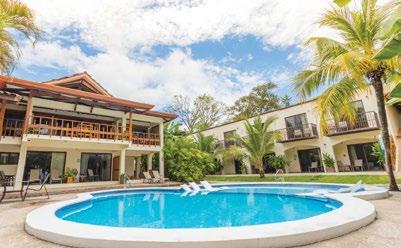
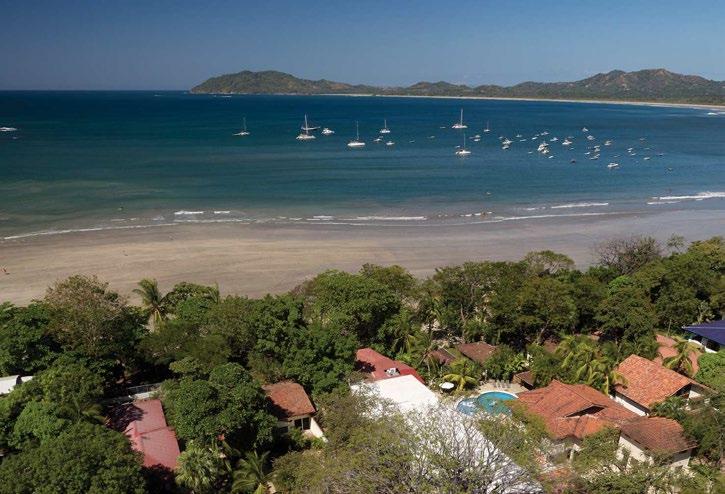
As people find Costa Rica an ideal place to live, enjoy or retire, many want to take advantage of the beautiful nature, scenery, oceans and fishing.

You can opt to lease a boat or apply for a chartering license, as we explained in our article published in the October 2022 edition of Howler: Chartering in Costa Rica for International Vessels is Allowed.
For anyone wanting to bring down your own ship and register it here, we’ve prepared this month’s article on the process to be followed.
According to section 60 of Reglamento Organización Registro Público de la Propiedad Mueble (RORPPM), a ship is "any floating device capable of transporting people and things, intended for navigation by water, whatever its class or size."
Before the Registro Público de la Propiedad Mueble, ships, vessels, jet skis, etc., must be registered, as well as any encumbrances or lien that affect them.
A public deed, signed by the owner, details the boat’s specifications and characteristics: length, beam, strut, hull material, hull number if applicable, net weight, gross weight, brand, year of construction, series if indicated, ship name (which must be different from any other registered), and the activity it will be dedicated to. Also, the engine's characteristics must be described: type, model, serial number, power, and fuel. The estimated contract value must be indicated, including the engine's value. (Section 39 paragraph 2. a RORPPM)
a) Property tax payment is required for recreational class boats, sport fishing, and jet skis. The tax is paid based on the value of motor vehicles, ships, and aircraft in the local market, according to their characteristics, and by the minimum percentages and amount published by the government. (Section 9 Law 7088 Regulation
Property Tax Vehicles, Boats and Aircraft).
Property tax payment is required for recreational class boats, sport fishing boats, and jet skis.
b) Verification of the payment of the fee established in section 33 of Law 8000, "Creation of the National Coast Guard Service": Applies to all boats and ships, except for "artisanal fishing," when the length is less than 10.67 meters. The fee is established based on the size of the vessel and ranges from 10% (46,200 colones) to 15% (69,300 colones) of the basic salary of an office worker, currently 462,200.00 colones. This amount adjusts yearly.
c) Stamps for registration. Proof of the tax department indicating the fiscal value ("value stamp") for recreational class boats, sport fishing, and jet skis. As for the other types of ships, that proof is not necessary; the calculation of stamps is based on the tax estimate made by the interested party.
This is carried out by the authorized inspectors of the Maritime Transportation Department of the MOPT (Section 65 RORPPM).
Owners of boats dedicated to tourist activities must provide a copy, certified by a notary public or the Costa Rican Tourism Institute, of the tourist contract and proof that the company and the boat are declared of tourist interest (Law on Incentives for Tourism Development No. 6990).
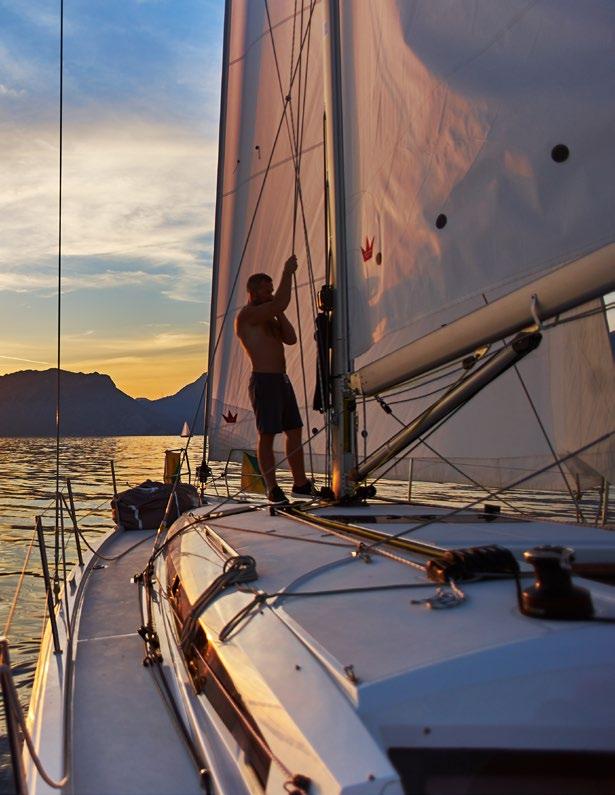
Click logo for the rest of the story:




















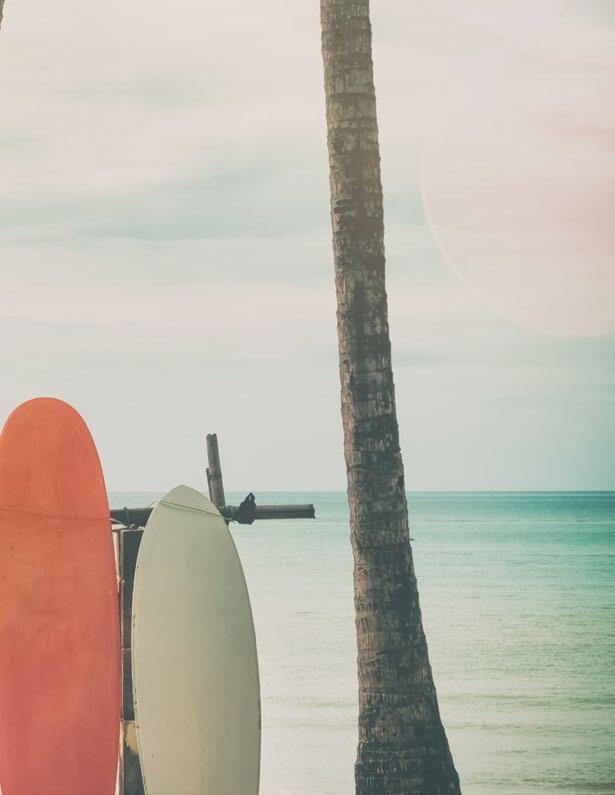

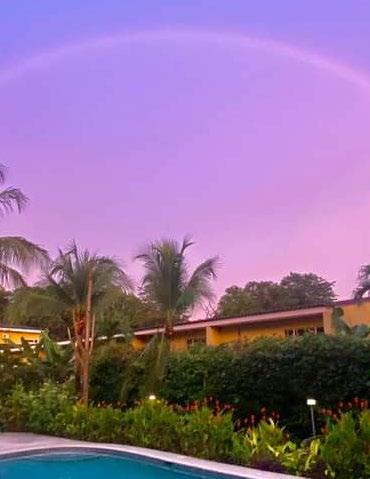 Photo by Deanne Willock Wasson
Photo by Deanne Willock Wasson


Both condos are modern, with three bedrooms and three bathrooms, located close to seven of Costa Rica's most beautiful beaches. They offer 1,150 square feet of air-conditioned space, plus a back porch, private rear garden, parking pad for two cars, and a paved roadway in a safe, friendly gated community.

The HOA fee is a low $175 per month with excellent property management and good reserve funds.
The open floor plan offers a spacious feel. The bedrooms have built-in closets and ceiling fans. The kitchen is equipped with a stainless steel stove and fridge, and a white washer/dryer unit. Countertops in the kitchen and bathrooms are all granite. There are ceramic tile floors throughout and screen doors on the front and back doors. These condos come fully furnished with everything you need to move right in.
The rancho and community pool are great for outdoor entertaining and a cool swim. The condos are located in Matapalo, a quaint Costa Rican town with convenience stores, where you will hear and see howler monkeys, birds, and iguanas.

It is a short drive to quality 24/7 medical care, several restaurants, and shops. Playa Grande (famous for surfing) is minutes away! Conchal Beach is 10 minutes the other way. Even the Liberia international airport is only a 50-minute drive.



Email for further information or to schedule a showing. crrealescapes@gmail. com or WhatsApp: +506-8995-5497

These condos come fully furnished with everything you need to move right in.


High-quality construction and design in a quiet secluded area — it’s all yours, within an easy 10-minute drive to the area’s beaches, and just 20 minutes from the popular communities of Tamarindo and Flamingo.
This classic Spanish hacienda-style house optimizes all its tropical living space, inside and out: 125 square meters under interior roof, expansive front and back patios measuring 55 square meters with a two-vehicle carport. This is all situated on a 1,645 square-meter, treecovered lot in a small, off-the-beaten-path subdivision of quality homes.
The three-bedroom floor plan incorporates two bedrooms / common bathroom and a master bedroom / bathroom. The open great room features exposed beams and high vaulted ceilings encompassing the spacious kitchen, dining and entertainment areas. The covered patios bring the tropics to your doorstep.
As a turnkey property, “Casa Escondite” is completely ready to live in or rent out. The home is tastefully finished and fully furnished with all necessities.
This home for sale in Matapalo, Guanacaste, Costa Rica, offers the best of both worlds — privacy and convenience. With no through-traffic at this dead-end, low-traffic gravel road, the only noise is that of monkeys and birds.

The house is located just 450 meters off the main road and two minutes either way to the small towns of Matapalo or Huacas for shopping convenience. The drive to Playa Grande or the south end of Playa Conchal takes just over 10 minutes. Tamarindo and Flamingo are both a 20-minute drive.
Pase de Terras is a residential oasis with a sense of remoteness. The landscape configuration of buildings and trees ensures adequate shade and breeze for reduced reliance on air conditioning, as well as protection from the strong north winds and dust during the dry season.
Contact: crrealescapes@gmail.com or WhatsApp +506-8995-5497 to schedule a showing. Brokers welcome.
